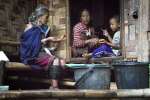Thailand: UNHCR calls for end of three-year detention of Lao Hmong
Briefing Notes, 17 November 2009
This is a summary of what was said by UNHCR spokesperson Andrej Mahecic – to whom quoted text may be attributed – at the press briefing, on 17 November 2009, at the Palais des Nations in Geneva.
Today, 17 November, marks three years since a group of recognized Lao Hmong refugees were rounded up in Bangkok for deportation. The group, now totalling 158, have been in detention ever since. UNHCR calls on all parties to play their part in finding a humanitarian solution to their plight and end the detention of this group of children, women and men who are being held in two cells in an immigration detention centre in Nong Khai, Thailand.
Many of the Hmong living in the highlands of Laos took part in the war that engulfed Laos in the 1960s and 1970s. When the Pathet Lao came to power in 1975, many tens of thousands of Lao Hmong fled to Thailand seeking asylum, and large numbers were resettled in Western countries, mostly in the United States.
The situation of the Hmong today is very different from what it was in the 1970s, but the Nong Khai group are part of the legacy left by a troubled past. Originally 147 refugees, they were rounded up for deportation and transferred on 08 Dec. 2006 to the Nong Khai immigration detention centre on the Mekong River border with Laos where they have been held since. With babies born in detention, the number now stands at 158.
Four countries – the U.S., Australia, Canada and the Netherlands – have offered resettlement places to the refugees, and we believe they should be allowed to leave Thailand for resettlement. They have not committed any crime, and their detention serves no purpose. We believe that a solution for this group will not only respond to an urgent humanitarian need but also help turn one of the final pages in the refugee history of the Hmong in Thailand.
Refugees from Myanmar: Ethnic Karens Seek Shelter
Over 2,000 refugees from Myanmar have crossed the border into Thailand in recent months. Most claim to be fleeing renewed conflict and human rights abuses in Kayin state, Myanmar. The mainly ethnic Karen refugees say their houses and villages have been burned and civilians killed. Many were weak upon arrival, suffering from illnesses such as malaria, after a long, dangerous journey to the camps through heavily mined areas. The refugees have been arriving at government-run camps, mainly in the Mae Hong Son area in northern Thailand.
UNHCR is working with the Thai government and non-governmental organisations to ensure the new arrivals are admitted to the camps and provided with adequate shelter and protection. Shelter has been a major issue as the capacity in many refugee camps has been overwhelmed. In a breakthrough in mid-May, Thai authorities agreed to build proper houses for the new arrivals.
There are currently 140,000 refugees from Myanmar living in nine border camps in Thailand, many of them have been there for up to 20 years.
Refugees from Myanmar: Ethnic Karens Seek Shelter
Angelina Jolie revisits Myanmar refugees on World Refugee Day
UNHCR's Special Envoy Angelina Jolie spent this year's World Refugee Day with Karenni refugees from Myanmar. Some have been in exile in Thailand for 30 years, making this one of the longest-running refugee situations in the world.
On her fourth visit to the refugee camps in Thailand, Jolie met Baw Meh's family, three generations of refugees who have lived in Ban Mai Nai Soi camp since 1996.
The family told Jolie they fled Myanmar's Kayah state thinking they would return home shortly. Eighteen years later, they are still here. Baw Meh, 75, lost her husband last year. He died before he could fulfill his dream of returning home. Some of their family members have been resettled to third countries. Others have chosen to stay. Baw Meh has refused to go, preferring to stay close to her village.
Like many refugees along the border, her family is watching the reform process in Myanmar closely and mulling the prospect of eventual return. "After 30 years in exile, the best solution we can give these refugees is the right and power to choose their own way forward," said Jolie. "This is our chance to get it right, to break the vicious cycle of conflict and displacement once and for all."
Angelina Jolie revisits Myanmar refugees on World Refugee Day


There are more refugees and displaced people now than at any time since the Second World War
To help them, to know who they are, to give them support now and in the future UNHCR must use the most modern tools available. UNHCR plans to capture refugees' biometrics in up to 10 countries this year, and in all its operations by 2018.


Thailand: Nader, a saxophonist from Syria - World Refugee Day 2015
"Music has helped me in everything - morally, financially, even my manners." Nader is a third-generation refugee.


Thailand: Thang's Dilemma
Thang is a refugee in Thailand. He and his mother fled his village because he feared being forced to join an army that was killing his own people. No one chooses to be a refugee.
 |
|  |
|  |
| 






























